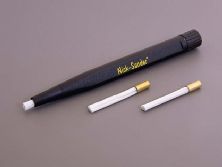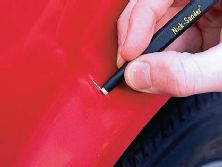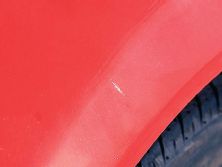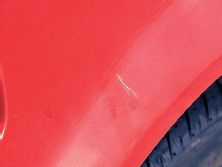It's a harsh world, full of indifferent Fortune's slings and arrows. For cars, these often come in the form of rocks and gravel that leave chips or scratches in the paint as their calling cards. If these blemishes are few in number, they can usually be repaired with touch-up paint. We've all seen touched-up chips that looked terrible, though--it turns out that just as with any other paint work, proper preparation is the foundation of quality results. A proper repair will blend smoothly with its surroundings and with the primer underneath it. Obviously, sanding will be required, but that seems inelegant if it enlarges the repair to many times the size of the original damage. Taken to an extreme, one might as well go ahead and respray the entire panel.
It so happens that the right solution is a small, inexpensive and simple tool called a Nick-Sander(TM). Similar to a felt-tip pen, its business end is a bundle of glass fibers that are just hard enough to be used as an abrasive on paint, and lightly on metal. In fact, the fibers' softness creates a self-regulating effect. When the roughness is gone and the nicked area smooth, force is distributed evenly across the many bristles and cutting slows appreciably. The tip's narrowness allows you to clean and smooth a repair area without appreciably enlarging it.
For any repairs you do on your own car, you are advised to follow an appropriate body-repair manual and the relevant material instructions. However, the following suggestions may prove helpful: Always begin any work by applying a wax remover to the area. Working it into the nooks of the damage with a stiff bristled brush is better than just wiping it with a cloth. Repeat the process after sanding, before applying any paint or primer. If the sanded chip goes through to bare metal, touch up the area with primer. After applying the color touch-up coats, be sure to color sand and polish the area to smooth it into the rest of the paint. Even with an imperfect color match, the repair should not be noticeable then, due to its small size. Such an easy process can be easy to misuse: repairing three or five chips makes sense. Individually fixing 50 scars is silly. Somewhere in between lies the decision to paint a whole panel and have it be perfect.
Because small pieces of glass fiber are constantly breaking off from the pen, safety glasses are a must, and clean latex or nitrile gloves are highly recommended. The Nick-Sander should be available through your local auto parts retailer for a few dollars; it includes two refills for the glass-fiber bristles.
Instructions for a complete repair and a jumping off point for further detailing hints can be found at the following website: www.web-cars.com/detail/touchup.html.




